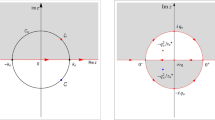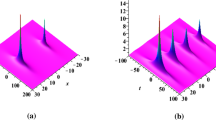Abstract
In this article we derive the reflectionless solutions of the 2 + 2 matrix NLS equation with vanishing boundary conditions and four different symmetries by using the matrix triplet method of representing the Marchenko integral kernel in separated form. Apart from using the Marchenko method, these solutions are also verified by direct substitution in the 2 + 2 NLS equation.
Similar content being viewed by others
References
Ablowitz, M.J., Kaup, D.J., Newell, A.C., Segur, H.: The inverse scattering transform – Fourier analysis for nonlinear problems. Stud. Appl. Math. 53, 249–315 (1974)
Ablowitz, M.J., Prinari, B., Trubatch, A.D.: Discrete and continuous nonlinear Schrödinger systems. Cambridge University Press, Cambridge (2004)
Aktosun, T., Busse, T.h., Demontis, F., van der Mee, C.: Symmetries for exact solutions to the nonlinear Schrödinger equation. J. Phys. A 43, 025202 (2010)
Aktosun, T., Demontis, F., van der Mee, C.: Exact solutions to the focusing nonlinear Schrödinger equation. Inverse Problems 23, 2171–2195 (2007)
Bart, H., Gohberg, I., Kaashoek, M.A.: Minimal factorization of matrix and operator functions, Birkhäuser OT 1, Basel (1979)
Camassa, R., Falqui, G., Ortenzi, G., Pitton, G.: Singularity formation as a wetting formalism in a dispersionless water wave model. Nonlinearity 32, 4079–4116 (2019)
Camassa, R., Falqui, G., Ortenzi, G., Pedroni, M., Thomson, C.: Hydrodynamic models and confinement effects by horizontal boundaries. J. Nonlin. Sci. 29, 1445–1498 (2019)
Demontis, F.: Direct and inverse scattering of the matrix Zakharov-Shabat system, Ph.D. thesis, University of Cagliari, 2007; also: Lambert Acad. Publ., Saarbrücken (2012)
Demontis, F., Lombardo, S., Sommacal, M., Vargiu, F.: Effective generation of closed-form soliton solutions of the continuous classical Heisenberg ferromagnet equation. Commun. Nonlinear Sci. Numer. Simul. 64, 35–65 (2018)
Demontis, F., Ortenzi, G., van der Mee, C.: Exact Solutions of the Hirota Equation and Vortex Filaments Motion. Physica D 313, 61–80 (2015)
Demontis, F., Prinari, B., van der Mee, C., Vitale, F.: The inverse scattering transform for the focusing nonlinear Schrödinger equation with asymmetric boundary conditions. J. Math. Phys. 55(101505), 40 (2014)
Demontis, F., van der Mee, C.: Marchenko equations and norming constants of the matrix Zakharov-Shabat system. Operators and Matrices 2, 79–113 (2008)
Demontis, F., van der Mee, C.: Explicit solutions of the cubic matrix nonlinear Schrödinger equation. Inverse Problems 24, 025020 (2008)
Eckert, K., Zawitkowski, Ł., Leskinen, M.J., Sanpera, A., Lewenstein, M.: Ultracold atomic Bose and Fermi spinor gases in optical lattices. New Journal of Physics 9(5), 133 (2007)
Faddeev, L.D., Takhtajan, L.D.: Hamiltonian methods in the theory of Solitons. Springer, Berlin and Heidelberg (2007)
Golub, G.H., Van Loan, C.F.: Matrix computations, 4th edn. John Hopkins University Press, Baltimore (2013)
Grabowski, M.: Second harmonic generation in periodically modulated media, Photonic Band Gaps and Localization, NATO ASI Series B, Vol. 308, 453–458, Springer US, Boston (1993)
Grabowski, M.: Bichromatic wave propagation in periodically poled media. Phys. Rev. A 48, 2370–2373 (1993)
Hirota, R.: The direct method in Soliton theory. Cambridge University Press, Cambridge (2004)
Ho, T.-L., Yip, S.: Pairing of fermions with arbitrary spin. Phys. Rev. Lett. 82, 247–250 (1999)
Ieda, J., Miyakawa, T., Wadati, M.: Exact analysis of soliton dynamics in spinor Bose-einstein condensates. Phys. Rev. Lett. 93, 194102 (2004)
Ieda, J., Uchiyama, M., Wadati, M.: Dark soliton in F = 1 spinor Bose-Einstein condensates. J. Phys. Soc. Jpn 75, 064002 (2006)
Lunquist, P.B., Andersen, D.R., Kivshar, Y.S.: Multicolor solitons due to four wave mixing. Phys. Rev. E 57, 3551–3555 (1998)
Moro, A., Trillo, S.: Mechanism of wave breaking from a vacuum point in the defocusing nonlinear Schrödinger equation. Phys. Rev. E 89, 023202 (2014)
Prinari, B., Demontis, F., Li, S., Horikis, T.: Inverse scattering transform and soliton solutions for square matrix nonlinear Schrödinger equations with non-zero boundary conditions. Physica D 368, 22–49 (2018)
Prinari, B., Ortiz, A., van der Mee, C., Grabowski, M.: Inverse scattering transform and solitons for square matrix nonlinear matrix nonlinear Schrödinger equations. Stud. Appl. Math. 141, 308–352 (2018)
Uchiyama, M., Ieda, J-i, Wadati, M.: Inverse scattering method for square matrix nonlinear Schroedinger equation under nonvanishing boundary conditions. J. Math. Phys. 48, 013507 (2007)
van der Mee, C.: Nonlinear evolution models of integrable type, SIMAI e-Lecture Notes 11. Torino (2013)
Wu, C.: Competing orders in one dimensional spin-3/2 fermionic systems. Phys. Rev. Lett. 95, 266404 (2005)
Wu, C.: Hidden symmetry and quantum phases in spin-3/2 cold atomic systems. Modern Phys. Lett B 20, 1707–1738 (2006)
Acknowledgments
The research leading to this article has been partially supported by the Regione Autonoma della Sardegna in the framework of the research programs Integro-Differential equations and non-local problems and Algorithms and Models for Imaging Science [AMIS], and by INdAM-GNFM (Istituto Nazionale di Alta Matematica, National Institute of Advanced Mathematics – Gruppo Nazionale per la Fisica Matematica, National Group for Mathematical Physics).
Author information
Authors and Affiliations
Corresponding author
Additional information
Publisher’s Note
Springer Nature remains neutral with regard to jurisdictional claims in published maps and institutional affiliations.
Appendices
Appendix
A Integral Equations for Kernel Functions
In this appendix we list the integral equations for the auxiliary functions \(\overline {K}(x,y,t)\), K(x, y, t), L(x, y, t), and \(\overline {L}(x,y,t)\). Their proof can be found in the literature [2, 8, 28]. For the sake of brevity, we omit the time variable in all equations.
We have the following Volterra integral equations for the kernel functions:
as well as
Equations (A.1a) and (A.2a) obviously imply (2.8a).
Suppose that F(y) is a matrix function of y ≥ x ≥ x0 or a matrix function of y ≤ x ≤ x0. Then we define
as well as
The unique solvability of (A.1a) and (A.2a) now follows immediately by applying Gronwall’s inequality.
Using Gronwall’s inequality we get
where we have used that ∥Q(z)∥≡∥R(z)∥.
Equations (2.8a) and (2.8b) are to be interpreted as follows: The integral terms in (A.1a) and (A.2a) are continuous in \(y\in [x,+\infty )\) and in \(y\in (-\infty ,x]\), respectively. As a result,
where we have substituted \(z=\tfrac {1}{2}[x+y]\). If the entries of Q(x) and Qx both belong to \(L^{1}(\mathbb {R},dx)\), then (2.8a) and (2.8b) are valid pointwise.
Rights and permissions
About this article
Cite this article
Demontis, F., van der Mee, C. Reflectionless Solutions for Square Matrix NLS with Vanishing Boundary Conditions. Math Phys Anal Geom 22, 26 (2019). https://doi.org/10.1007/s11040-019-9323-7
Received:
Accepted:
Published:
DOI: https://doi.org/10.1007/s11040-019-9323-7
Keywords
- Matrix Nonlinear Schroedinger equation
- Inverse scattering transform
- Matrix triplets method
- Reflectionless solutions




